Echeveria Pulvinata (Chenille Plant) Care & Propagation Guide
Written by Iris
Nov 03 2021
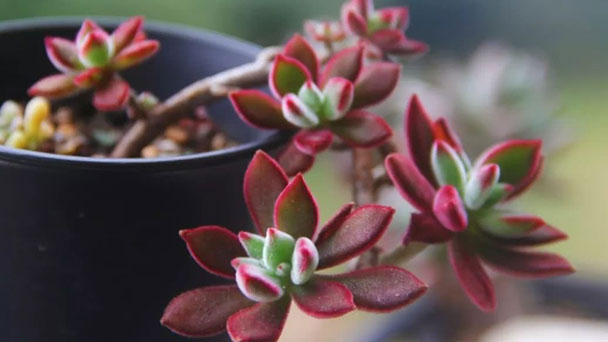
Echeveria Pulvinata (Chenille plant) is a species of Echeveria Pulvinata, native to Oaxaca, Mexico. Echeveria Pulvinata succuelnt has a rose-like shape. Tiny white hairs cover the leaves, giving them a velvety feel. The rosettes grow to three to four inches wide. Echeveria Pulvinata has velvety green leaves and red tips, and bell-shaped orange flowers adorn this beautiful succulent. Flowers develop in the cooler months. Environmental stress gives this velvety succulent a red color.
This type of succulent prefers a warm climate. It can survive at zone 9b-11b which is around -3.9°C (25°F). If you live in a cold area, it is better to plant Ruby in an indoor environment. As long as it gets enough sunlight, the plant will grow happily. When selecting what pot to use be sure that you understand the difference between the material used. (Find more best indoor hanging plants here.)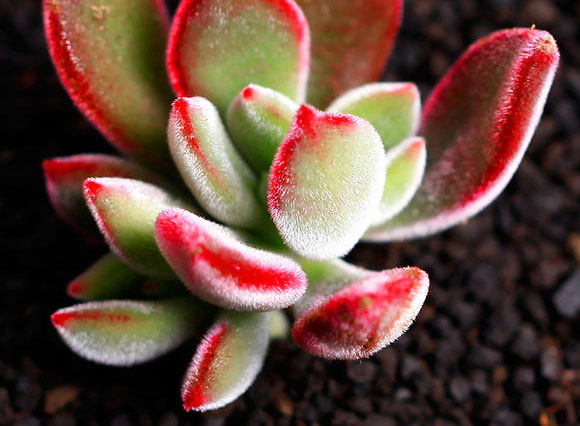
Leave the leaf to dry out for a few days so the callouses on the end will be over. Place on well-draining soil after that. When the soil is totally dry, water it.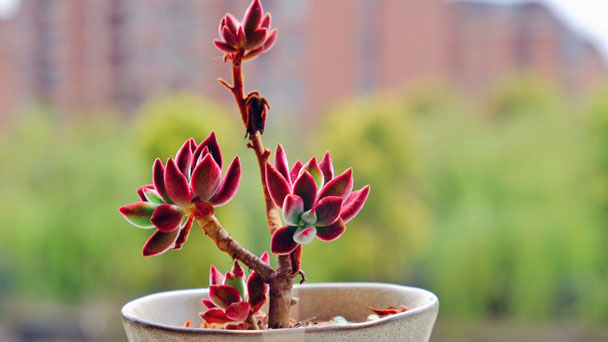
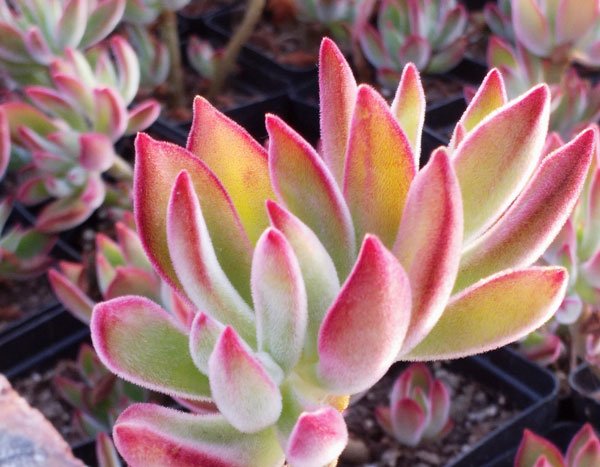
The most common pest is the Mealybug. If they aren’t dealt with quickly, these tiny creatures can cause significant damage to your plant. Mealybugs secrete a waxy substance that coats the leaves, resulting in curling or yellowing leaves from lack of sunlight exposure. In severe cases, this issue could also lead to death if not treated right away.
There are many ways to target these pests.
One is to use a cotton swab dipped in rubbing alcohol and carefully remove the pests with it. You can also purchase natural remedies designed specifically for these types of issues from your local gardening store.
A fungal disease called Echeveria leaf spot will occasionally affect this plant. Still, if you keep up with watering practices, then there won’t be any problems. This fungus usually starts as small brown spots on leaves which quickly grow to become larger, or they might appear as yellowish-brown patches.
The size gets bigger until the entire leaf turns brown and dies off completely unless treated right away with fungicide spray or powder – whichever one works best for your situation. It’s important to note that plants may be more susceptible to its recurrence once affected by this issue.
It’s recommended that you remove the infected plant parts, stop watering, and expose the leaves to direct sunlight for several hours a day.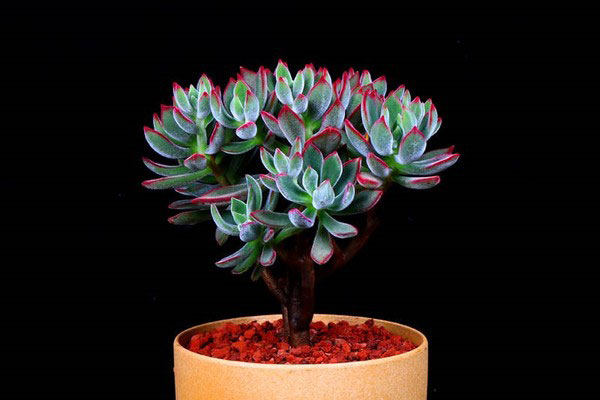
Ruby
Ruby, which also goes by the names Red Velvet, Ruby Blush or Ruby Slippers. A touch of color may be all that your garden needs, and this stands out succulent offers just that. Normally, plants get their color from flowers which bloom just once a year, though, with this plant, it is the leaves that offer the first dash of color. Like typical Echeveria pulvinate plants, it has fine white hairs covering the leaves. The difference here is that the tips and margins of the leaves have a deep red color, meaning the leaves are both green and red. This succulent is sure to make heads turn.
Frosty
Frosty, which is also known as the White Chenille Plant is a brilliant succulent that will thrive anywhere you plant it. The tiny white hairs are quite visible on this plant, giving it a ‘frosty’ look as though it will turn into a different plant if it spends some time in the warmth and defrosts. The leaves of this succulent are all green. Normally, it begins as a small succulent though it can grow into a large plant that reaches 12 cm in height. The blooms for this plant burst out through footlong brown stems, normally towards the very end of the cold season.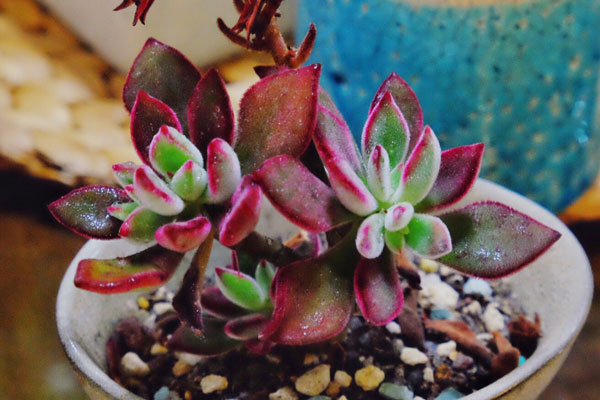
Read Next:
Echeveria Elegans Mexican Snowballs Care & Growing Guide
Echeveria Laui (Echeveria Succulent) Care Guide
Echeveria Agavoides Care & Propagation
Echeveria Nodulosa (Painted Echeveria) Care Guide
Echeveria Imbricata (Blue Rose Echeveria) Grow & Care Guide
Echeveria Setosa: Grow & Care for Mexican Firecracker
Echeveria Black Prince Succulent Grow & Care Guide
Echeveria Runyonii Topsy Turvy Grow & Care Guide
Echeveria Takasago No Okina Care Guide
Echeveria Mebina Care Guide
Where to Grow Echeveria PulvinataHow to Grow Echeveria Pulvinata (Chenille plant)Echeveria Pulvinata Propagation with SeedsEcheveria Pulvinata Propagation with Stem CuttingsEcheveria Pulvinata Propagation with LeavesHow to Care for Echeveria Pulvinata (Chenille plant)Echeveria Pulvinata LightingEcheveria Pulvinata Soil CareEcheveria Pulvinata WateringEcheveria Pulvinata Temperature & Humidity CareEcheveria Pulvinata Fertilizer CareEcheveria Pulvinata Pruning CareEcheveria Pulvinata Pests & DiseasesVarieties of Echeveria Pulvinata (Chenille plant)Echeveria Pulvinata Care FAQIs Echeveria Pulvinata Cold Hardy?Is Echeveria Pulvinata Toxic To PetsIs Echeveria Pulvinata An Indoor Plant?How Long Does It Take For Echeveria Pulvinata To Grow?
Where to Grow Echeveria Pulvinata
Echeveria Pulvinata (Chenille plant) succulents need strong light. When planting this succulent type in a garden, make sure it gets sunlight. Full to partial sun is the best for its growth. Echeveria Pulvinata is better to grow outdoor rather than indoor.This type of succulent prefers a warm climate. It can survive at zone 9b-11b which is around -3.9°C (25°F). If you live in a cold area, it is better to plant Ruby in an indoor environment. As long as it gets enough sunlight, the plant will grow happily. When selecting what pot to use be sure that you understand the difference between the material used. (Find more best indoor hanging plants here.)

How to Grow Echeveria Pulvinata (Chenille plant)
Produces small suckers at the base of stems, and these can be replanted and take root easily. The Echeveria Pulvinata plants can also propagated by leaf cuttings, and by seed if they are not hybrids.Echeveria Pulvinata Propagation with Seeds
Echeveria pulvinata (Chenille plant) is a slow grower so even if it can be propagated by its seeds, this method is not recommended. To propagate from the seeds, plant the seeds in a well-draining soil mixture. This method can be used outdoors. In cooler areas, indoor propagating is recommended.Echeveria Pulvinata Propagation with Stem Cuttings
Echeveria Pulvinata cutting should be done by using a sterile, sharp knife. Stem should be removed from the main plant. Then, it should be allowed to callous it for a few days before planting. Planting should be done in well-draining soil. Watering should be done after it is completed dry.Echeveria Pulvinata Propagation with Leaves
Twist a leaf from the mother plant to propagate echeveria pulvinata (Chenille plant) from leaves. (If some of the leaf stays attached to the stem, you would have a lower chance of success.)Leave the leaf to dry out for a few days so the callouses on the end will be over. Place on well-draining soil after that. When the soil is totally dry, water it.

How to Care for Echeveria Pulvinata (Chenille plant)
Echeveria Pulvinata Lighting
Echeveria Pulvinata (Chenille plant) plants can grow in a variety of conditions, from partial shade to full sun. These plants are exposed to maximum sunshine all year in their natural environment, which is why they like bright light. Make sure your plants are in places where they can get lots of good sunshine while still being protected from the hot afternoon sun.Echeveria Pulvinata Soil Care
To prevent overwatering, Echeveria Pulvinata (Chenille plant) should be planted in a mildly acidic (pH6.0) and porous soil with well-drained. commercial succulent mix can be used. but if you want to make your own, mix a 2:1 potting soil and coarse sand, or a 1:1:1 potting soil, perlite, and sand.Echeveria Pulvinata Watering
Echeveria Pulvinata plants need regular watering. Avoid pouring excess water into plants. Echeveria Pulvinata (Chenille plant) rots when you drop heavy water. Soaking and drying processes are healthy methods for Echeveria Pulvinata plants. Drop water thoroughly in summer. Reduce watering of Echeveria Pulvinata in winter. Don't water the leaves, just around the plant. If you water the leaves because the leaves of the plant are fuzzy, it can cause root rot. Water them regularly as they start to grow. This Echeveria Pulvinata plant looks attractive whether you place it indoors or outdoors as an indoor plant.Echeveria Pulvinata Temperature & Humidity Care
Since their thick leaves help avoid water loss, Echeveria Pulvinata plants can withstand high temperatures. However, they prefer mild temperatures and low to moderate humidity.Echeveria Pulvinata (Chenille plant) must grow in climates with temperatures above 20°C/68°F and remain stable over time. Temperatures below 10°C/50°F are deadly. Protect from strong winters in greenhouses.Echeveria Pulvinata Fertilizer Care
Fertilize the Echeveria Pulvinata (Chenille plant) as it begins to grow. Fertilizers can increase the strength of Echeveria Pulvinata. Feeding Echeveria Pulvinata in spring and summer. Avoid fertilizing during the cooler months. Fertilize once a month during plant growth. When fertilizing Echeveria Pulvinata, be careful with water soluble fertilizers. Observe the growth of the plant to see if it is fertilized. You can also make a plan to fertilize the Echeveria Pulvinata. Echeveria Pulvinata grows well in the summer. Summer is the season for fertilization.
Echeveria Pulvinata Pruning Care
Little need for pruning except in old plants. Echeveria Pulvinata (Chenille plant) can be pruned back when height is excessive for a particular growing situation, tops can be cut out and side branching will develop, eventually forming a full plant. Remove wilted flowers regularly (deadheading). This step isn’t mandatory but it will help stimulate the plant to produce new flowers.Echeveria Pulvinata Pests & Diseases
You should be aware of some pests and diseases when it comes to Echeveria Pulvinata plants.The most common pest is the Mealybug. If they aren’t dealt with quickly, these tiny creatures can cause significant damage to your plant. Mealybugs secrete a waxy substance that coats the leaves, resulting in curling or yellowing leaves from lack of sunlight exposure. In severe cases, this issue could also lead to death if not treated right away.
There are many ways to target these pests.
One is to use a cotton swab dipped in rubbing alcohol and carefully remove the pests with it. You can also purchase natural remedies designed specifically for these types of issues from your local gardening store.
A fungal disease called Echeveria leaf spot will occasionally affect this plant. Still, if you keep up with watering practices, then there won’t be any problems. This fungus usually starts as small brown spots on leaves which quickly grow to become larger, or they might appear as yellowish-brown patches.
The size gets bigger until the entire leaf turns brown and dies off completely unless treated right away with fungicide spray or powder – whichever one works best for your situation. It’s important to note that plants may be more susceptible to its recurrence once affected by this issue.
It’s recommended that you remove the infected plant parts, stop watering, and expose the leaves to direct sunlight for several hours a day.

Varieties of Echeveria Pulvinata (Chenille plant)
Echeveria Pulvinata has several variants that you can choose from, and here are two of the most loved.Ruby
Ruby, which also goes by the names Red Velvet, Ruby Blush or Ruby Slippers. A touch of color may be all that your garden needs, and this stands out succulent offers just that. Normally, plants get their color from flowers which bloom just once a year, though, with this plant, it is the leaves that offer the first dash of color. Like typical Echeveria pulvinate plants, it has fine white hairs covering the leaves. The difference here is that the tips and margins of the leaves have a deep red color, meaning the leaves are both green and red. This succulent is sure to make heads turn.
Frosty
Frosty, which is also known as the White Chenille Plant is a brilliant succulent that will thrive anywhere you plant it. The tiny white hairs are quite visible on this plant, giving it a ‘frosty’ look as though it will turn into a different plant if it spends some time in the warmth and defrosts. The leaves of this succulent are all green. Normally, it begins as a small succulent though it can grow into a large plant that reaches 12 cm in height. The blooms for this plant burst out through footlong brown stems, normally towards the very end of the cold season.

Echeveria Pulvinata Care FAQ
Is Echeveria Pulvinata Cold Hardy?
Echeveria Pulvinata (Chenille plant) succulent plant is not cold hardy. But, In USDA hardiness zones 9b-11b, the Echeveria Pulvinata succulent plant is winter hardy.Is Echeveria Pulvinata Toxic To Pets
Generally, Echeveria Pulvinata plants are not toxic to humans and pets.Is Echeveria Pulvinata An Indoor Plant?
No. Echeveria Pulvinata succulent plant is love to live in direct to partial sunlight.so, if the sun is shining well, the outdoors is the best place to plant Echeveria Pulvinata succulent plant. but it is not cold hardy, it’s safer to grow it in a container that can be taken indoors if you live in a region where the temperature drops below 20 degrees of Fahrenheit (-6.7 degrees of Celsius). Is better.How Long Does It Take For Echeveria Pulvinata To Grow?
Within about a few weeks, new Echeveria Pulvinata plants emerge from their own leaves. The duration of this process can vary from a few weeks to several months.Read Next:
Echeveria Elegans Mexican Snowballs Care & Growing Guide
Echeveria Laui (Echeveria Succulent) Care Guide
Echeveria Agavoides Care & Propagation
Echeveria Nodulosa (Painted Echeveria) Care Guide
Echeveria Imbricata (Blue Rose Echeveria) Grow & Care Guide
Echeveria Setosa: Grow & Care for Mexican Firecracker
Echeveria Black Prince Succulent Grow & Care Guide
Echeveria Runyonii Topsy Turvy Grow & Care Guide
Echeveria Takasago No Okina Care Guide
Echeveria Mebina Care Guide
Latest Updated
- Benefits of Bugleweed - 7 Science-backed Health Benefits
- Bugleweed Dangers & Side Effects - Is It Poisonous?
- How to Plant Evergreen Trees - What You Should Know
- When to Plant Evergreens - Grow Guide for Evergreen Trees
- 12 Wonderful Evergreen Shrubs for Your Garden
- 12 Popular Evergreen Plants with Pictures for Beginners
- When And How To Prune A Lilac Bush Like a Pro
- How to Grow & Care for Lilac Vine (Hardenbergia Violacea)
- Japanese Lilac Tree (Syringa Reticulata) Care & Propagation Guide
- Shumard Oak Pros and Cons - What to Know
Popular Articles
- Winter maintenance of Antirrhinum Majus
- How to Grow Terminalia Mantaly Tree
- How to Grow and Care for Crossostephium Chinense
- How to grow Antirrhinum Majus in spring
- Peristeria Elata (Dove Orchid) Profile: Info & Care Guide
- Underwatered Snake Plant (Sansevieria Trifasciata) - Signs And How To Fix
- How to Care for Brazilian Jasmine Plant (Mandevilla Sanderi)
- How to Grow & Care for Graptopetalum Purple Delight in Summer
- Rosa Chinensis (China Rose): Plant Growing & Care Tips
- How to Care for Baby Sun Rose (Aptenia Cordifolia)